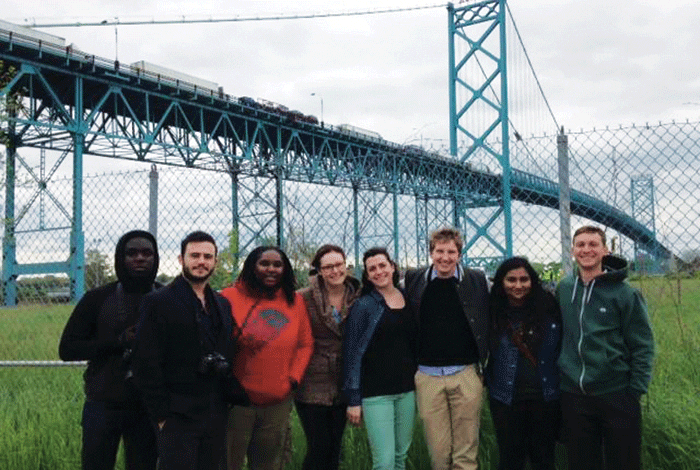
DETROIT — More Arab Americans are pursuing journalism careers to combat stereotypes perpetuated by mainstream media.
As the American media turned their attention to the Arab World after the 9/11 terrorist attacks and the recent turmoil in the Middle East, more Americans became increasingly interested in Arab and Muslim cultures and news.
However, the attention also included negative stereotypes, especially with the rise of bigotry that accompanies war. Reports from the Arab American Institute show that 40 percent of Arab Americans have experienced racial profiling and discrimination based on their ethnicity.
Ayah Alghanem, a Wayne State University journalism student, said that as a Syrian American, she has been affected by the media’s false representation of Arab Americans.
She said she felt targeted in the news, with wars going on around the areas where her parents grew up. As she grew older, she realized that the issues between the West and the Middle East were founded on interests, not values. That ignited her desire to uncover these issues.
“When I was growing up, I knew I wanted to choose a career that had an issue I was passionate about solving,” Alghanem said. “I believe minorities and individuals who come from different economic backgrounds should all be involved in the process of reporting events truthfully and from different perspectives.”
As media struggle to maintain objective reporting on politically and culturally sensitive topics like Middle Eastern conflicts, some outlets are actively trying to diversify their newsrooms with journalists of different ethnic backgrounds. Diversifying newsrooms ensures accuracy and fairness in reporting news stories involving minority groups and communities.
A 2013 Pew Research study shows that in the majority of U.S. daily newspapers, only 13 percent of the newsrooms’ workforce were minorities – a minor increase in the past two decades. Local television had a significantly better minority representation.
Although minorities are struggling to gain a presence in newsrooms, niche news publications, like ethnic newspapers, have seen an increase in circulation. Meanwhile, mainstream newspapers circulation are declining, according to another Pew Research study conducted that same year.
“It’s extremely important to have diverse newsrooms, because we live in a diverse country and it’s becoming more and more diverse,” said Joe Grimm, journalism professor at Michigan State University. “If your newsroom doesn’t look like your community, you really can’t reflect that community. And if you can’t reflect your community, how can you possibly be accurate in the big sense.”
Grimm said he sees an increase in minorities joining the MSU journalism program, partly because of a natural demographic growth and partly because more Arab Americans are realizing that no one is better at telling their community’s story than trained Arab American journalists.
He noted that Arab Americans are themselves an ethnically diverse group, consisting of more than 20 nationalities, several major religions and different languages and experiences, adding to accuracy and fairness of news reporting.
“Essentially, if Arab Americans aren’t telling the story, then the story won’t be told,” Grimm said. “Or people who might not really understand and feel the story will be telling it.”
Mayssa Masri, the arts and entertainment editor of Wayne State’s student newspaper, The South End, said she chose to major in journalism because it gave her a voice.
Masri said she grew up in a household heavily involved in human rights issues and became passionate about the Syrian and Palestinian conflicts.
She said she views journalism as a tool to change the negative stereotypes that she and her family have experienced.
Masri also said she hopes to humanize the struggle of people in the Middle East, as “real people with real lives and real stories to tell.”
As an editor of the school newspaper, Masri said she has noticed that an increasing number of Arab Americans and other minority students joining WSU’s journalism program. She added that these students play a major role in bringing different perspectives to the paper.
“We complain a lot about how the media portrays us, but if we make an effort to change the light that the media portrays us in, we would be in a different situation,” she said.
Mona Beydoun, an Eastern Michigan University student who writes for the school’s student newspaper, the Eastern Echo, said journalism can change the world.
“A journalist’s main job is to keep the public informed on what’s happening in the world,” she said. “Rather than fulfilling that responsibly, journalists often report on nonsense, which can turn people away from the industry. I think with the proper training, I can give, if not the world, than at least a community the information they need to participate as well-informed citizens.”
Beydoun said diverse perspectives in the newsroom neutralize reporters’ natural individual bias, adding that Arab American journalists offer new points of view to their outlets.
“Many Arab Americans come from households that have strong connections to Middle Eastern countries,” she said. “I know from experience that having a connection to another country, in my case Lebanon, gives me the ability to think beyond America and look at an issue in a different light.”
Jack Lessenberry, head of the journalism department at Wayne State University, said the school has witnessed more diversity and more Arab American students enrolling in the journalism program in the last 10 or 15 years.
“One of our goals here, especially with the Journalism Institute [for Media Diversity] is to make America’s newsrooms look more like America,” Lessenberry said. “So it would be a very good thing if the newsrooms of places, not only like the Arab American News, but the newsrooms of the Detroit Free Press, or the Detroit News, or WDIV, or the radio stations had a higher percentage of Arab Americans working there.”






Leave a Reply